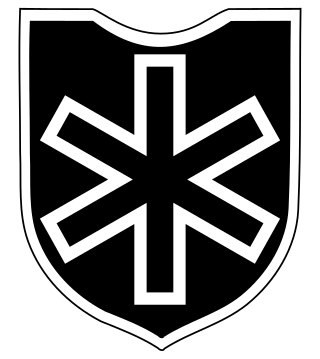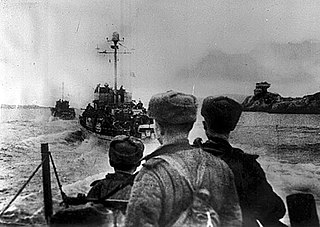
The Continuation War, also known as the Second Soviet-Finnish War, was a conflict fought by Finland and Nazi Germany against the Soviet Union during World War II. It began with a Finnish declaration of war and invasion on 25 June 1941 and ended on 19 September 1944 with the Moscow Armistice. The Soviet Union and Finland had previously fought the Winter War from 1939 to 1940, which ended with the Soviet failure to conquer Finland and the Moscow Peace Treaty. Numerous reasons have been proposed for the Finnish decision to invade, with regaining territory lost during the Winter War regarded as the most common. Other justifications for the conflict include Finnish President Risto Ryti's vision of a Greater Finland and Commander-in-Chief Carl Gustaf Emil Mannerheim's desire to annex East Karelia.

The 6th SS Mountain Division Nord was a World War II mountain infantry division of the Waffen-SS, the military wing of the German Nazi Party, primarily consisting of ethnic Germans along with some Norwegian and Swiss volunteers. It was the only Waffen-SS division to operate in the Arctic Circle.

Ferdinand Schörner was a German military commander who held the rank of Generalfeldmarschall in the Wehrmacht of Nazi Germany during World War II. He commanded several army groups and was the last Commander-in-chief of the German Army.

Operation Arctic Fox was the codename given to a World War II campaign by German and Finnish forces against Soviet Northern Front defenses at Salla, Finland in July 1941. The operation was part of the larger Operation Silver Fox which aimed to capture the vital port of Murmansk. Arctic Fox was conducted in parallel to Operation Platinum Fox in the far north of Lappland. The principal goal of Operation Arctic Fox was to capture the town of Salla and then to advance in the direction of Kandalaksha to block the railway route to Murmansk.

Operation Silver Fox from 29 June to 17 November 1941, was a joint German–Finnish military operation during the Continuation War on the Eastern Front of World War II against the Soviet Union. The objective of the offensive was to cut off and capture the key Soviet Port of Murmansk through attacks from Finnish and Norwegian territory.
The XXXVI Corps was a German military formation in World War II.

The 2nd Mountain Division was a Gebirgsjäger division of the German Army which served in World War II, mainly in the northernmost sector of the Eastern Front, near the Arctic. Formed in 1938, the division was disbanded at the end of the war in 1945.

The 3rd Mountain Division was a formation of the German Wehrmacht during World War II. It was created from the Austrian Army's 5th and 7th Divisions following the Anschluss in 1938.

Eduard Wohlrat Christian Dietl was a German general during World War II who commanded the 20th Mountain Army. He received the Knight's Cross of the Iron Cross with Oak Leaves and Swords.
Operation Platinum Fox was a German and Finnish military offensive launched during World War II. Platinum Fox took place on the Eastern Front and had the objective of capturing the Barents Sea port of Murmansk. It was part of a larger operation, called Operation Silver Fox.

The Petsamo–Kirkenes offensive was a major military offensive during World War II, mounted by the Red Army against the Wehrmacht in 1944 in the Petsamo region, ceded to the Soviet Union by Finland in accordance with the Moscow Armistice, and Norway. The offensive defeated the Wehrmacht's forces in the Arctic, driving them back into Norway, and was called the "Tenth Shock" by Stalin. It later expelled German forces from the northern part of Norway and seized the nickel mines of Petsamo.
The 14th Army was a field army of the Soviet Army, formed twice.

The 10th Guards Motor Rifle Division was a division of the Soviet Ground Forces. The full name of its predecessor division was the 10th Guards Rifle Pechengskii, Twice Order of the Red Banner, Order of Alexander Nevsky, Order of the Red Star Division. The 10th Guards Rifle Division was formed from the 52nd Rifle Division in late 1941.
Army Norway,, was a German army operating in Norway and Finland during World War II. It was one of the two army echelon headquarters controlling German troops in the far north. Army Norway was directly subordinate to OKH, the high command headquarters of the Wehrmacht. It was created from Army Group XXI in December 1940, itself a successor of the XXI Army Corps, and disbanded in December 1944, with its tasks and assets taken over by the 20th Mountain Army.
Ferdinand Alfred Friedrich Jodl was a German general during World War II who commanded the Mountain Corps Norway during the Petsamo–Kirkenes Offensive. He was the younger brother of Alfred Jodl, Chief of the Operations Staff of the OKW.
The 14th Rifle Division was an infantry division of the Red Army. Formed in Moscow in 1922, the division spent most of the interwar period at Vladimir. After moving to the Kola Peninsula during the Winter War, the division fought on that front during the Continuation War. After the end of the Continuation War it became the 101st Guards Rifle Division.
XXXXIX Mountain Corps was a mountain warfare corps of the German Army during World War II.
The 114th Rifle Division began service in July 1939 as a standard Red Army rifle division, as part of the pre-war expansion of the Soviet forces. It was stationed on the Svir River front in the autumn of 1941 and had a relatively uneventful war facing the Finns until the Vyborg–Petrozavodsk Offensive began on June 10, 1944, from which point it saw much more active service. As the Finns were leaving the war the division was transferred to 14th Army in the Arctic, from where it helped to defeat and pursue the German forces from Lapland into Norway.
The LXX Army Corps, initially known as Higher Command z. b. V. LXX or Höh.Kdo.70, was an army corps of the German Wehrmacht during World War II. Throughout the war, it was deployed in occupied Norway.
The LXXI Army Corps, initially known as Higher Command LXXI or Höh.Kdo. röm. 71, was an army corps of the German Wehrmacht during World War II. The corps was deployed in March 1942. Throughout the war, it was stationed in the north of occupied Norway.









